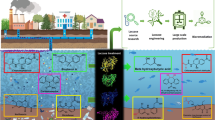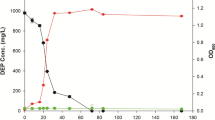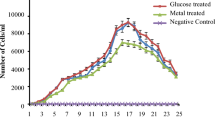Abstract
Biodegradation of poorly soluble polycyclic aromatic hydrocarbons (PAHs) has been a challenge in bioremediation. In recent years, surfactant-enhanced bioremediation of PAH contaminants has attracted great attention in research. In this study, biodegradation of phenanthrene as a model PAHs solubilized in saline micellar solutions of a biodegradable commercial alcohol ethoxylate nonionic surfactant was investigated. The critical micelle concentration (CMC) of the surfactant and its solubilization capacity for phenanthrene were examined in an artificial saline water medium, and a type of marine bacteria, Neptunomonas naphthovorans, was studied for the biodegradation of phenanthrene solubilized in the surfactant micellar solutions of the saline medium. It is found that the solubility of phenanthrene in the surfactant micellar solutions increased linearly with the surfactant concentrations, but, at a fixed phenanthrene concentration, the biodegradability of phenanthrene in the micellar solutions decreased with the increase of the surfactant concentrations. This was attributed to the reduced bioavailability of phenanthrene, due to its increased solubilization extent in the micellar phase and possibly lowered mass transfer rate from the micellar phase into the aqueous phase or into the bacterial cells. In addition, an inhibitory effect of the surfactant on the bacterial growth at high surfactant concentrations may also play a role. It is concluded that the surfactant largely enhanced the solubilization of phenanthrene in the saline water medium, but excess existence of the surfactant in the medium should be minimized or avoided for the biodegradation of phenanthrene by Neptunomonas naphthovorans.
Similar content being viewed by others
References
Allen CCR, Boyd DR, Hempenstall F, Larkin MJ & Sharma ND (1999) Contrasting effects of a nonionic surfactant on the biotransformation of polycyclic aromatic hydrocarbons to cis-dihydrodiols by soil bacteria. Appl. Environ. Microbiol. 65: 1335–1339
Dyksterhouse SE, Gray JP, Herwig PR, Lara JC & Staley JT (1995) Cycloclasticus pugetti gen.nov., sp. nov., an aromatic hydrocarbon-degrading bacterium from marine sediments. Int.J.Syst.Bacteriol. 45: 116–132
Doong RA & Lei WG (2003) Solubilization and mineralization of polycyclic aromatic hydrocarbons by Pseudomonas putida in the presence of surfactant. J. Hazar. Mater. 96: 15–27
Efroymson RA & Alexander M (1991) Biodegradation by an Arthrobacter species of hydrocarbons partitioned into an organic solvent. Appl. Environ. Microbiol. 57: 1441–1447
Grimberg SJ & Aitken MD (1995) Biodegradation kinetics of phenanthrene solubilized in surfactant micelles. In: Hinchee RE, Brockman FJ & Vogel CM (Eds.), Microbial Processes for Bioremediation (pp. 59–66). Battelle Press, Columbus, OH
Grimberg SJ, Nagel J & Aitken MD (1995). Kinetics of phenanthrene dissolution into water in the presence of nonionic surfactants. Environ. Sci. Technol. 29: 1480–1487
Grimberg SJ, Stringfellow WT & Aitken MD (1996) Quantifying the biodegradation of phenanthrene by Pseudomonas stutzeri P16 in the presence of a nonionic surfactant. Appl. Environ.Microbiol. 62: 2387–2392
Guha S & Jaffé PR (1996) Bioavailability of hydrophobic compounds partitioned into micellar phase of nonionic surfactants. Environ. Sci. Technol. 30: 1382–1391
Hedlund BP, Geiselbrecht AD, Bair TJ & Staley JT (1999) Polycyclic aromatic hydrocarbon degradation by a new marine bacterium, Neptunomonas naphthovorans gen. nov., sp.nov. Appl. Environ. Microbiol. 65: 251–259
Johnson JC, Sun SB & Jaffé PR (1999) Surfactant enhanced perchloroethylene dissolution in porous media: the effect on mass transfer rate coefficients. Environ. Sci. Technol. 33: 1286–1292
Laha S & Luthy RG (1992) Effect of nonionic surfactants on the solubilization and mineralization of phenanthrene in soil-water systems. Biotechnol. Bioeng. 40: 1367–1380
Li JL & Chen BH (2002) Solubilization of model polycyclic aromatic hydrocarbons by nonionic surfactants. Chem. Eng. Sci. 57: 2825–2835
Liu ZB, Jacobson AM & Luthy RG (1995) Biodegradation of naphthalene in aqueous nonionic surfactant systems. Appl. Environ.Microbiol. 61: 145–151
Mizesko MC, Grewe C, Grabner A & Miller MS (2001) Alterations at the Ink4a locus in transplacentally induced murine lung tumors. Cancer Lett. 172: 59–66
Mulligan CN, Yong RN & Gibbs BF (2001) Surfactant-enhanced remediation of contaminated soil: a review. Eng. Geol. 60: 371–380
Tsai PJ, Shieh HY, Lee WJ & Lai SO (2001) Health-risk assessment for workers exposed to polycyclic aromatic hydrocarbons (PAHs) in a carbon black manufacturing industry. Sci. Total. Environ. 278: 137–150
Tsomides HJ, Hughes JB, Tomas JM & Ward CH (1995) Effect of surfactant addition on phenanthrene biodegradation in sediment. Environ. Toxicol. Chem. 14: 953–959
Van der Meeren P & Verstraete W (1996) Surfactants in relation to bioremediation and wastewater treatment. Current. Opin. in Colloid. Interf. Sci. 1: 624–634
Volkering F, Breure AM, van Vandel & Rulkens WH (1995) Influence of nonionic surfactants on bioavailability and biodegradation of polycyclic aromatic hydrocarbons. Appl. Environ. Microbiol. 61: 1699–1705
Author information
Authors and Affiliations
Rights and permissions
About this article
Cite this article
Li, Jl., Bai, R. Effect of a commercial alcohol ethoxylate surfactant (C11-15E7) on. Biodegradation 16, 57–65 (2005). https://doi.org/10.1007/s10531-004-0429-1
Issue Date:
DOI: https://doi.org/10.1007/s10531-004-0429-1




